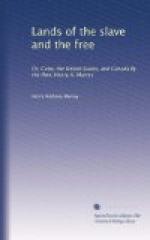[Footnote CJ: The foregoing details are essentially extracted from a work by Mr. Woodcroft, professor of machinery at University College, London; who, after proving that the previous inventions of his countrymen were combined together, for the first time, in the boat engined by Symington, thus clearly and summarily disposes of the pretensions put forward in favour of Fulton:—“In fact, if these inventions separately, or as a combination, were removed out of Fulton’s boat, nothing would be left but the hull; and if the hull could then be divested of that peculiarity of form, admitted to have been derived from Colonel Beaufoy’s experiments, all that would remain would be the hull of a boat of ordinary construction."]
CHAPTER XXX.
Adverse Influences.
I now come to the consideration of the annual celebration of the 4th July, an event which presents itself to my mind under two opposite aspects, the one beneficial, the other injurious. If contemplated as a nation’s grateful acknowledgment to Providence for the successful termination of an arduous struggle for independence, it assumes an aspect at once dignified and Christian; but if into its celebration other elements enter which are calculated to nourish hostile feelings towards those who have long ceased to reciprocate such unworthy sentiments, in that case I think its aspect may be fairly termed both injurious and unchristian.
Let me then call your attention to the method of celebration. It consists of three parts:—First, the reading of the Declaration of Independence; secondly, an oration on the subject; lastly, procession and jollification.
Now what is the Declaration of Independence? It is a document which details their views of the oppression and injustice which justified their rebellion against the mother country. The clauses are too numerous to quote in full, but I subjoin a few, that the reader may form his own opinion. Speaking of the sovereign of Great Britain, they say he has protected “armed troops among us, by a mock trial, from punishment for any murders which they should commit on the inhabitants of these States. He has plundered our seas, ravaged our coasts, burnt our towns, and destroyed the lives of our people. He is, at this time, transporting large armies of foreign mercenaries to complete the works of death, desolation, and tyranny, already begun, with circumstances of cruelty and perfidy scarcely paralleled in the most barbarous ages, and totally unworthy the head of a civilized nation. He has constrained our fellow-citizens taken captive on the high seas, to bear arms against their country, to become the executioners of their friends and brethren, or to fall themselves by their hands. He has excited domestic insurrections amongst us, and has endeavoured to bring on the inhabitants of our frontiers, the merciless Indian savages, whose known rule of warfare is an undistinguished destruction of all ages, sexes, and conditions. In every stage of these oppressions, we have petitioned for redress in the most humble terms; our repeated petitions have been answered only by repeated injury. A prince whose character is thus marked by every act which may define a tyrant, is unfit to be the ruler of a free people.”




